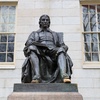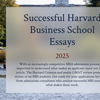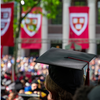This is the first installment of a two-part feature on Mormon undergraduates at Harvard.
They still shun smoking and drinking, but their practice of polygamy died with the covered wagon. And not all three million-plus members of the Church of Jesus Christ of Latter-day Saints live in Salt Lake City and hold degrees from Brigham Young University either.
Most Easterners picture Mormons as eccentrics. And cosmopolitan Harvard is no exception; ask students here what they know about Mormons, and You're likely to get a wry smile and some lighthearted kidding about cigarettes and liquor and low divorce rates.
But there are Latter-day Saints in New England (14,000 at last count), including the 700 members of three congregations that share a modest brick church off Brattle Street in Longfellow Park. Many of the 700 are affiliated with universities in the Boston area: one of the units--the second Cambridge ward--overflows with married students enrolled at Harvard's graduate and professional schools and includes several married undergraduates. The third congregation, which is technically only a "branch" because its members are generally single, has 11 Harvard undergraduates. Newly seated as president of the "University branch"--a job that mixes the roles of an administrator, leader and father confessor--is Harvard's vice president for alumni affairs, Dr. Chase Nebeker Peterson '52.
The tall, balding and bespectacled Peterson doesn't shed his whimsical manner when he begins to talk about Mormonism and the University branch. "We're like the People's Republic of China without force," the grandson of a Wyoming homesteader suggested after a church service earlier this fall. Mormons, he joked, are industrious, follow good health rules, and have no venereal disease.
As if to stress Mormons' devotion, Peterson--who doubles as the Bok administration's chief money-raiser--held out the check a church member had just given him. (Mormons still tithe at least 10 per cent of their gross pre-tax income; a University branch member once in charge of collections says he cried when he first saw how much church members had given.) In a later interview in his Mass Hall office, Peterson would brag that "in three hours we could mobilize 100 people by telephone to dismantle the Lars Anderson bridge. I don't think anyone else except the Spartacist League or a unit from Peking could match that."
Founded in the 1820s by a New Yorker named Joseph Smith, the Church of Jesus Christ of Latter-day Saints is now centered in Utah where Smith's followers moved after being chased out of Midwestern towns they had tried to settle in. A fundamentalist religion, it places heavy emphasis on the Bible, but also gives equal power to the Book of Mormon, which church doctrine says is Smith's translation of golden tablets he found under the guidance of a holy messenger. The book tells the story of ancient inhabitants of America descended from the Lost Tribes of Israel and includes a story of Christ's appearance in South America after his resurrection. The Mormon god is a personage and, in the words of one Harvard Mormon, "is a very real god, who works in your life, guides you, affects you." Mormons also believe in modern-day revelation and the eternal progression of man and are prohibited from using alcohol, tobacco, coffee, and tea by the Word of Wisdom, one of Smith's revelations.
Being a devout Mormon here or outside Harvard can be an all-consuming affair, for the lay church, which holds services all day on Sunday, has no clergy. Instead it relies on the tightly organized work of its members, all of whom are assigned some job, be it branch president, Sunday school director or athletic coordinator.
The Sunday services of the University branch open at 12:30 p.m. with separate 60-to-90-minute meetings of the relief society and priesthood. While the relief society is all women and tends to focus on domestic needs as well as spiritual and cultural education, the priesthood--which includes only men--concentrates on learning to live the Mormon faith at home and to bring it to others. One priesthood gathering this fall, run much like a jovial high-school class meeting and held in a cramped basement room of the church--offered plans for a visit to the new $15 million, all marble Oz-like Mormon temple in Washington, D.C. ("a rocket base," one Mormon called it), a demonstration of baptism, and a McCarthy-era training film on missionary work.
At 2 p.m. the two groups united for Sunday school in the first-floor chapel, a spacious but simple chamber without stained glass windows or other religious symbols. While over 100 branch members sat scattered through the rows of wooden benches divided by two aisles, Peterson, his assistants in the branch presidency, and several Harvard undergraduates who arranged or participated in the service sit up front on the dias in theater seats with green padding. This 90-minute service, followed by separate classes on Mormon doctrine and the final Sacraments meeting at 6:30 p.m., included individual speeches and music. The Mormon hymns have a sharp pioneer flavor. ("Come, ye thankful people, come, Raise the song of harvest home; All is safely gathered in, Ere the winter storms begin...")
Returned Missionaries
Early this fall the Crimson carried a brief letter to the editor protesting publication of a suggestive advertisement for the "Stimola Condom." ("It's like hundreds of tiny fingers urging a woman to let go," the ad promised.) The letter's author, Matt A. Thomas '77, objected to the graphics and text of the ad and to the "type of sex relations the product facilitates"--pre-marital sex. He added, "I believe sex between married partners can be the highest expression of love...Any person can and should develop the discipline and self control to postpone such gratification until he chooses to accept all the responsibilities of marriage. I believe this to be ultimately the most satisfying approach to sex."
Although a junior this year, Matt Thomas first arrived at Harvard in fall 1971, a refugee from the Salt Lake Mormon environment that he had begun to find stifling. He was, he says, just slightly more than a "cultural Mormon": like many Mormons raised in the heavily Mormon atmosphere of Utah or some nearby Western state, he was still troubled by questions about the church. "I did not," the tall, lanky and bearded Kirkland House resident stresses. "want to go to BYU."
That October, Thomas's roommate, an Oregonian named R. Mark Molton '75, asked Thomas to outline the Mormon church. "We called it quits at 5 the next morning," Thomas recalls with a smile. By next March--when Molton converted--Thomas's pedagogical role had "clarified" his own thoughts and doubts. That summer he decided to take up a mission--a two-year period of proselytizing inside or outside the United States--joining a predominantly male group of 18,000 Mormons. (Eleven Harvard undergraduates are out on missions this year.) These years of "dealing consistently with your feelings and with others" in northern France and French-speaking Belgium resolved Thomas's commitment, and he now explains the church doctrine with the polish of one who has many times confronted a skeptic.
Matt's story sounds much like that of Larry Dewey '73, a first-year Medical School student who graduated from the college last year and is now a resident proctor in Greenough and lives with his wife Teresa and one-year-old daughter Andrea. Dewey arrived at Harvard in fall 1969 from a rural area ten miles outside Boise, Id. ("Out in the sticks," he admits with a chuckle.) "I got here and just hated the place. At home I could go pheasant and rabbit and deer hunting of fish and catch 20-inch trout. But here there are no mountains, the air is dirty, and you can't see the stars at night," he says.
Read more in News
Lindsay Says American Diplomats Fail to Understand Chinese GoalsRecommended Articles
-
Students Favor Religion Over StudiesFor a handful of rising sophomores, religion will outrank randomization as the main housing issue for the next two years.
-
Mormon TempleOn a clear fall Sunday this week, thousands of worshippers converged on a hilltop in Belmont, Mass. to dedicate the
-
Mixing Faith and FeminismLaurel Thatcher Ulrich identifies herself a "Mormon feminist." On the surface that label seems a bit of an oxymoron; the
-
Two Dispassionate Looks At the Latter-day SaintsMuch has been written about the Mormons since Joseph Smith founded the Church of Jesus Christ of Latter-day Saints in
-
THE BOOKSHELFMormons were more than men who were lucky enough to have several wives. They were a civilization, a religion, and
-
Mannequins and MormonsT HE MORNING was dark and drizzly, ugly in a way that only New York can be. Snarling people, filthy













